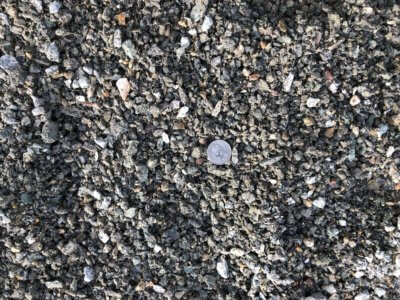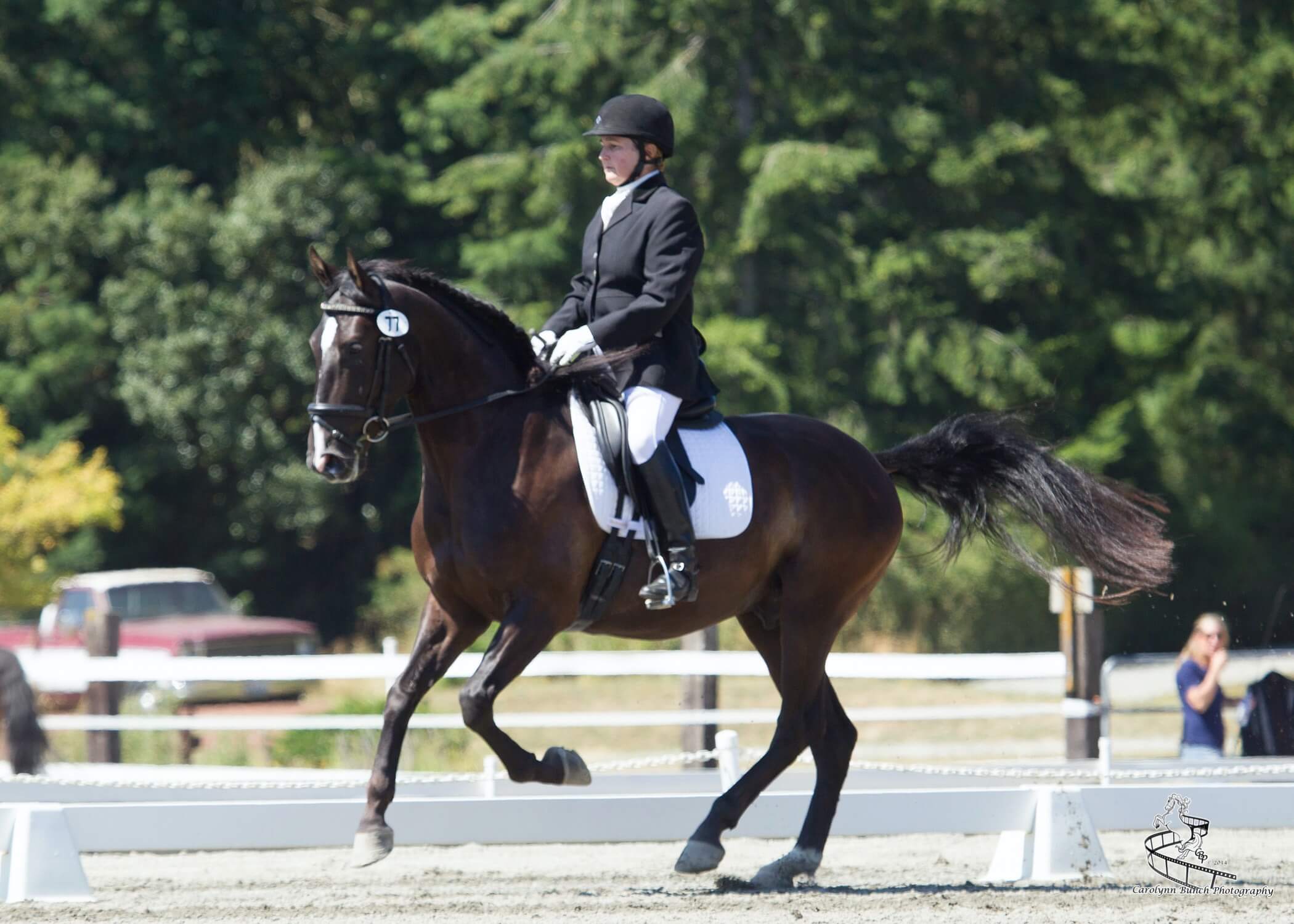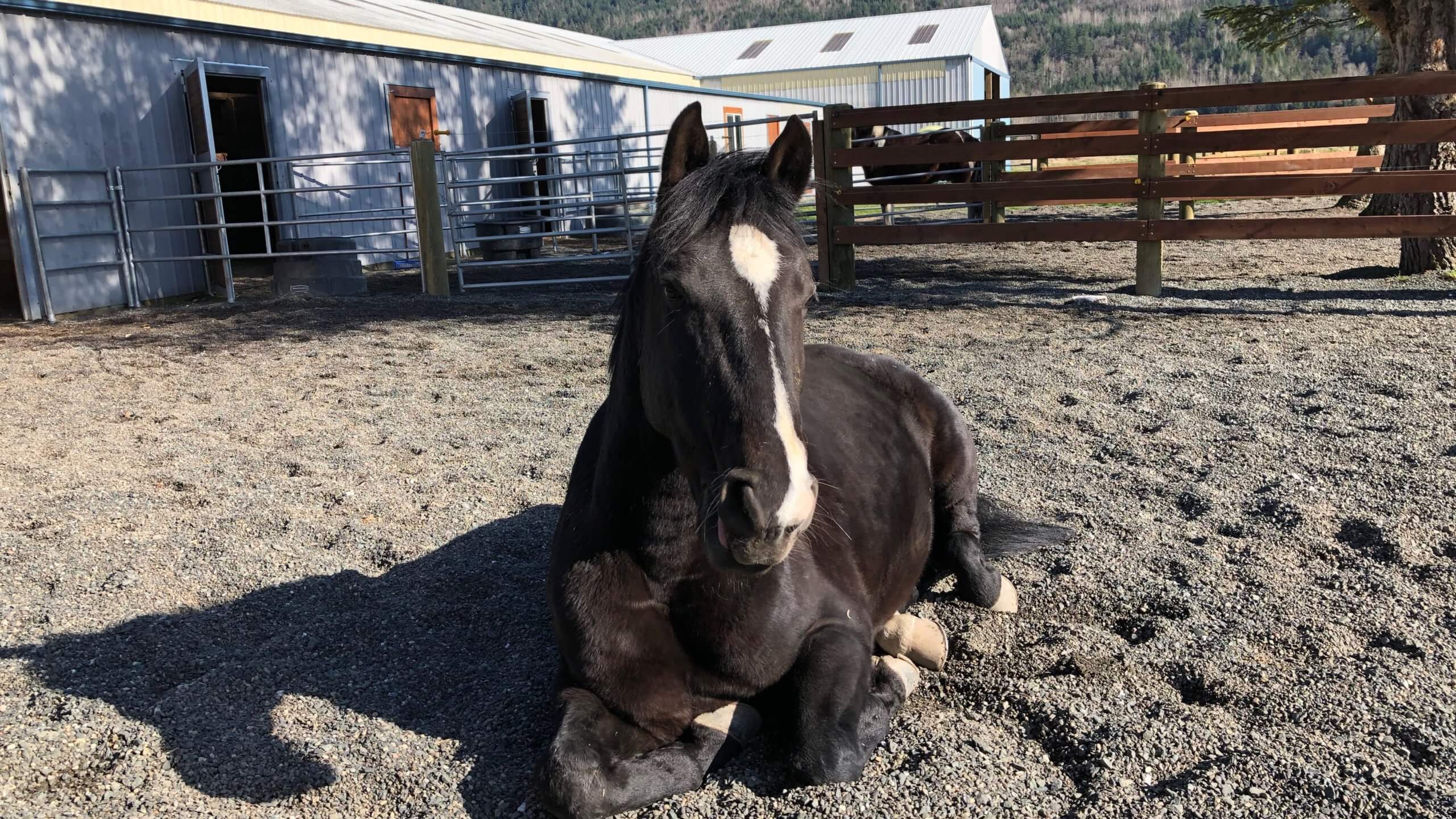I live in a river valley in the Pacific Northwest. With annual rainfall amounts close to 50 inches per year and clay soil on my farm, I’ve spent much of the 30 years I’ve lived here perfecting mud control. I’m often asked about the best footing choices for sacrifice areas. I have plenty of advice (and opinions) on what works best.
After using hog fuel (wood chips) for about a decade, I decided to switch to gravel paddocks. Wood creates a fungi and bacteria super-site, which can wreak havoc on hooves. It breaks down quickly and becomes a soggy mess that’s hard to clean. Hog fuel also holds water and is slippery when frozen. Every few years you need to remove it and start over with fresh stuff. So, it’s very labor intensive. The one nice thing about hog fuel is horses like to roll and sleep in it and they stay very clean on it. Gravel can leave your horse almost as dirty as mud does.
Here’s what I’ve learned about gravel.
Base Layer: Two-inch or Larger Crushed Rock (and Sometimes Pit Run)
When preparing your paddocks, you need to remove all the “organic” material such as grass, sod, manure, roots, etc. Before switching to gravel, I removed all the hog fuel from my paddocks which left large wet holes in my paddocks. I took the inexpensive route and filled them in with pit run, which ended up sinking into the mud and creating a really nice base. Pit run is hard to work with, though, and can be poor quality. The larger rocks might get dug up by your horses and cause injury too. Using two-inch crushed gravel with fines (smaller pieces of rock and sand) as your base might be the better choice. The fines help the gravel pack and stay put. For best results use a compactor to pack the gravel in.
As for depth I have some areas where the base layer is 18 inches deep and others where it is only 6 inches. Depth depends on how low an area is and how well it drains. But don’t be stingy with this layer. It’s important that the dirt and mud below not work up into the upper layer of gravel.
Middle Layer: 5/8 Crushed with Fines
I find 5/8-inch gravel with fines (also referred to as 5/8 minus) makes a really nice middle layer. I can push it around easily with my tractor bucket and rake it out by hand to “shape” the paddock so that water rolls out of the paddocks. It packs really well. The pieces of rock are small enough to not get caught in my manure fork or cause injury to my horses’ feet if they work up into my top layer—something that is fairly likely with horses running, playing, and digging in their paddocks. This layer needs to be thick enough that the horses don’t dig into your base layer when playing, rolling, or digging in their turn outs.
Top layer: 3/8 Minus or Pea Gravel

Pea gravel is a round, smooth (not crushed), rock without fines. It’s sometimes called drain rock and can be found in various sizes. For horse paddocks it’s best in the 5/8 and slightly smaller varieties. Pea gravel has become popular in recent years for the top layer of horse paddocks. Most horses will roll and sleep in it and it’s fairly easy on hooves—even barefoot ones. It’s not my first choice, though, for two reasons: One, I find it hard to push a heavy wheelbarrow through pea gravel, and second, since it doesn’t pack it tends to migrate, leaving the paddock with low and high spots where water collects.

I prefer hard-packed crushed gravel that’s easy to clean and water flows over the top into drainage situated on the outside of the pens. My favorite top layer is 3/8 minus which packs well, drains well, and is still soft enough for horses to enjoy rolling and sleeping in. Any smaller than this and it’s more like sand and can be quite dusty. This layer needs to be at least 3-6 inches deep.
Thoughts on Sand
Sand can make a nice topping, especially when piled far away from a horse’s stall and/or eating area. It’s luxurious for horses to sleep on, but dangerous for them to ingest if they track it into their food. Use with caution. I’ve placed sand in a few of my paddocks for laminitic or older horses who need an especially soft area to sleep and/or stand on. Choose a heavier, round, sand. Do not use fine or dusty sand like the type used to make concrete.
A Few Final Thoughts
Gravel paddocks make life easier in the wet Northwest, but horses should never be fed on gravel as they can ingest it leading to colic or tooth damage. Also, if your horse hasn’t been on gravel and is suddenly barefoot and put in gravel, they can become quite foot sore until their feet toughen up. If your horses live on gravel year-round, their hooves may become very dry in the summer. Pasture time in the morning dew, or soaking hooves in water, helps to alleviate this. Finally, I am continually adding to my gravel paddocks—filling in holes and adding more top layer for a sleeping cushion. If you invest in a tile system (see this month’s cover story) your gravel will last longer. Be diligent about cleaning, as any hay or manure will eventually turn to mud destroying your investment.
More resources to improve your barn, check out our Farm & Ranch section.
See this article in the 2021 February online edition:

Kim Roe grew up riding on the family ranch and competed in Western rail classes, trail horse, reining, working cow, and hunter/jumper. She trained her first horse for money at 12 years old, starting a pony for a neighbor.
Kim has been a professional dressage instructor in Washington state for over 30 years, training hundreds of horses and students through the levels. In recent years Kim has become involved in Working Equitation and is a small ‘r’ Working Equitation judge with WE United.
Kim is the editor of the Northwest Horse Source Magazine, and also a writer, photographer, and poet. She owns and manages Blue Gate Farm in Deming, Washington where she continues to be passionate about helping horses and riders in many disciplines.







How the heck do I pick/scoop horse manure out of the -3/8 gravel WITHOUT also scooping a bunch of gravel?! I don’t want to have to get a half-yard of gravel every month!
Use a manure fork. The tines are farther apart than 3/8 inches so pea gravel or 3/8 minus will fall through.
Any top base with minus will compact like concrete? That is not a very comfortable base for my horses.
We use 3 in of pea gravel it’s firm yep pliable very good for their feet instead of a hard pack.
As stated in the article, pea gravel can be nice for some horses to lie down in, as can sand. As I said in the article, you trade off the softness for a little more difficulty pushing the wheelbarrow through the deep pea gravel. Pea gravel can also migrate, leaving an unlevel surface which might be a problem for some people. I use deeply bedded stalls that my horses always have access to for a bed, but as you can see from the top photo my horse is sleeping in his pen with a pea gravel topping.
Thanks for your article Kim. We are above you – in British Columbia Canada. I recently moved our mare to a different facility and she now has a gravel paddock (she had hogfuel before). The only thing I am noticing is that in the last week or so she has some cuts/scrapes on her (front leg) knees and some cuts that bleed on her (front leg) pastern areas – at the front and side. Both front leg knees and both front leg pasterns. I’m assuming it is because of the gravel when she is laying down.
Her covered lean-to stall (in the paddock) has rubber mats. And her stall (inside the barn overnight) has rubber mats.
I thought about putting some sand in an area over the gravel for her to lay in – but worry about sand colic or if it would wash away when it rains. Her paddock is more at the “top” of all of the other paddock on the slightly inclined area.
And I don’t know if putting hogfuel in an area over the gravel for her to lay in would create mud or again, wash away into the other paddocks.
Suggestions? Thanks!